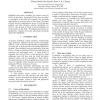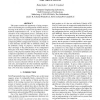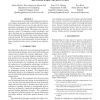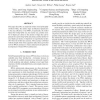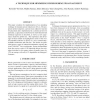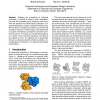111
Voted
FPL
2008
Springer
15 years 2 months ago
2008
Springer
It is often desirable to change the logic and/or the connections within an FPGA design on-the-fly without the benefit of a workstation or vendor CAD software. This paper presents ...
96
Voted
FPL
2008
Springer
15 years 2 months ago
2008
Springer
Reliability and process variability are serious issues for FPGAs in the future. Fortunately FPGAs have the ability to reconfigure in the field and at runtime, thus providing oppor...
134
Voted
FPL
2008
Springer
15 years 2 months ago
2008
Springer
This paper examines the opportunity of using compression for accelerating the (re)configuration of FPGA devices, focusing on the choice of compression algorithms, and their hardwa...
103
click to vote
FPL
2008
Springer
15 years 2 months ago
2008
Springer
Energy research in reconfigurable architectures often involves legacy benchmarks such as the MCNC benchmarks. These benchmarks, however, are not well-suited for assessing energy c...
105
Voted
FPL
2008
Springer
15 years 2 months ago
2008
Springer
This paper describes an analytical model, based principally on Rent's Rule, that relates logic architectural parameters to the area efficiency of an FPGA. In particular, the ...
FPL
2008
Springer
15 years 2 months ago
2008
Springer
This paper considers the implementation of an annealing technique for dynamic power reduction in FPGAs. The proposed method comprises a power-aware objective function for placemen...
97
Voted
FPL
2008
Springer
15 years 2 months ago
2008
Springer
: Modeling the interactions of biological molecules, or docking is critical to both understanding basic life processes and to designing new drugs. Here we describe the FPGA-based a...
122
click to vote
FPL
2008
Springer
15 years 2 months ago
2008
Springer
A high-speed and secure dynamic partial reconfiguration (DPR) system is realized with AES-GCM that guarantees both confidentiality and authenticity of FPGA bitstreams. In DPR syst...
113
click to vote
FPL
2008
Springer
15 years 2 months ago
2008
Springer
A hybrid FPGA consists of island-style fine-grained units and domain-specific coarse-grained units. This paper describes an approach to estimate the power consumption of a set of ...
FPL
2008
Springer
15 years 2 months ago
2008
Springer

